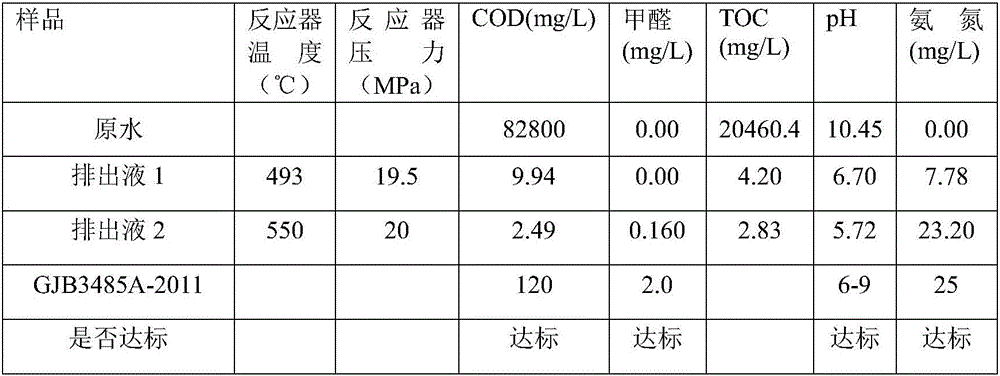Method and system for overheating near-critical water oxidation of unsymmetrical dimethylhydrazine waste liquor
A technology of near-critical superheat and unsymmetrical dimethylhydrazine, which is applied in chemical instruments and methods, oxidized water/sewage treatment, natural water treatment, etc. It can solve the problem that intermediate products are difficult to meet the emission standards and the ratio of chemical reagents is difficult to control. , elimination and other issues
- Summary
- Abstract
- Description
- Claims
- Application Information
AI Technical Summary
Problems solved by technology
Method used
Image
Examples
Embodiment 1
[0045] For the untreated unsymmetrical dimethylhydrazine waste liquid with a concentration of 4.74wt%, oxygen is used as an oxidant, and the amount of the oxidant is 0.9-1.1 times the oxygen demand calculated according to the chemical reaction formula. Add 60ml of unsymmetrical dimethylhydrazine liquid in 1 liter of water, prepare 10 liters of unsymmetrical dimethylhydrazine solution of this concentration as the waste liquid to be treated, put the prepared waste liquid into figure 1 In the waste liquid tank 2, inject 10 liters of tap water in the clean water tank 1, close the waste liquid shut-off valve 4, open the clean water shut-off valve 3, close the back pressure valve 14, open the waste liquid pump 5, and supply the first preheater 6 of the system , The second preheater 7 and the reactor 8 are filled with clean water, and the heating facilities of the first preheater 6, the second preheater 7 and the reactor 8 are turned on at the same time, and the temperature of the pre...
Embodiment 2
[0049] Same as Example 1, except that the unsymmetrical dimethylhydrazine waste liquid with a concentration of 7.37wt% is used, and the dosing ratio of the oxidant is 1.0-1.2. Add 100ml unsymmetrical dimethylhydrazine pure liquid in 1 liter of water, prepare altogether 5 liters as waste liquid to be treated, operation process is identical with example 1, and detection result is as shown in table 2. The removal rate of chemical oxygen demand (COD) reaches 99.96%, the removal rate of total organic carbon (TOC) reaches 99.96%, and other indicators meet the emission requirements of GJB3485A-2011.
[0050] Table 2 Test results of drainage samples
[0051]
[0052] It can be seen from Table 1 and Table 2 that after treatment, the COD removal rate of the pollutant index reaches more than 99.95%, and the COD, formaldehyde, pH, and ammonia nitrogen in the effluent all meet the discharge requirements of GJB3485A-2011, realizing the pollutant The up-to-standard discharge solves the p...
PUM
 Login to View More
Login to View More Abstract
Description
Claims
Application Information
 Login to View More
Login to View More - R&D
- Intellectual Property
- Life Sciences
- Materials
- Tech Scout
- Unparalleled Data Quality
- Higher Quality Content
- 60% Fewer Hallucinations
Browse by: Latest US Patents, China's latest patents, Technical Efficacy Thesaurus, Application Domain, Technology Topic, Popular Technical Reports.
© 2025 PatSnap. All rights reserved.Legal|Privacy policy|Modern Slavery Act Transparency Statement|Sitemap|About US| Contact US: help@patsnap.com



